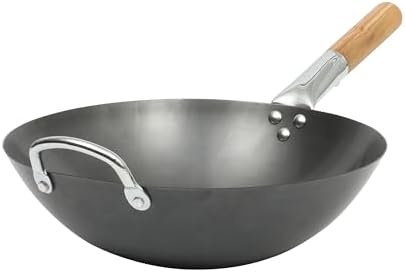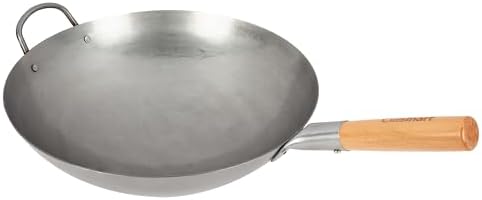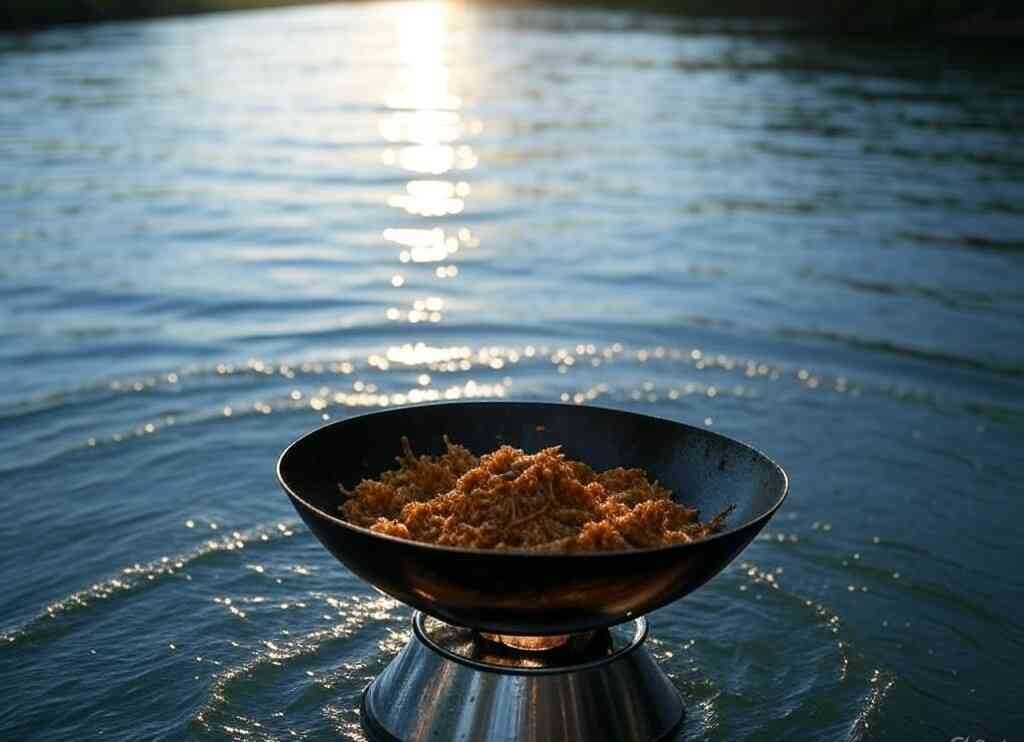Understanding Carbon Steel Woks
Carbon steel woks are an essential part of equipment used in professional kitchens and households. People adore them because of their brilliant cooking abilities. They are made predominantly using carbon and iron. They are greatly prized for their uniform heating abilities. This allows for well-regulated temperatures during cooking. This aspect comes in handy while utilizing the stir-fry method. Stir-frying is a technique that demands quick heat and rapid cooking intervals. This allows food to retain freshness and texture.
One of the most significant benefits of carbon steel is its excellent heat retention. A carbon steel wok, once well-heated, can maintain high temperatures. It is required for developing the intricate flavors and textures of Chinese food. Carbon steel also possesses a natural non-stick quality once well-seasoned. This makes food release simple and cleanup a breeze. This is not exclusive to stir-frying. Carbon steel woks can be utilized for deep-frying, steaming, and even baking. While these are the advantages carbon steel woks possess, they rust if they are not properly maintained.
The iron content would react with water in the air.
This leads to oxidation. The common issues that lead to rusting are not drying them properly after washing, keeping them in humid environments, or failing to season. Maintenance is significant in retaining the cooking function and longevity of the wok. Periodic seasoning of the wok by applying a thin layer of oil after each use not only enhances its non-stick surface but also creates a protective layer against moisture and air, hence preventing rust from developing. Therefore, understanding the characteristics and care requirements of a carbon steel wok is important. This is for individuals who desire to fully enjoy the benefits of this wonderful kitchen tool. With proper care, a carbon steel wok can be a valuable and cherished partner in any culinary quest.
Evaluating Your Rusty Wok
Assessing the Damage: Evaluating Your Rusty Wok
When restoring a rusted carbon steel wok, the first thing one has to do is complete damage assessment. Identifying the extent of rust and how it affected the cookware is vital. This will determine whether it can be repaired or not, and whether it should be replaced or not. Begin by visually inspecting the interior and exterior of the surfaces for signs of rust. A rusty wok may have varied degrees of discoloration. This ranges from light marks to heavy, flaky patches of rust.
The second step involves the identification of the level of rust.
Typically, there are two types: superficial rust, typically superficial and loose, and deep-rusting rust.
Deep-rusting rust alters the structural integrity of the wok. It can be gauged by touching the surface with caution. A rough and irregular surface indicates a bad situation. It is also advisable to check for pitting. Pitting occurs when the rust eats into the metal and produces small pits. A wok with severe pitting may be lost. Also think about rust on the outside. This may indicate storing it improperly. An outside rusted surface does not necessarily render it unusable. It might, however, require cleaning and re-seasoning. Considering whether the wok can be saved, how far the rust has progressed is significant. If rust spans the majority of the cooking area, restoration could be too expensive in relation to purchasing one new. Safety is also a consideration. Cooking with a highly rusted wok can have health effects. Rust can be transferred to food. In case uncertainty exists about the safety of the wok once restored, consult cooking safety guidelines. Expert advice can also be obtained. Correctly identifying the damage will allow you to make proper judgments on whether to restore or replace your rusty carbon steel wok.
Step-by-Step Restoration Process
It is a rewarding process to refurbish a rusty carbon steel wok. It can significantly extend its lifespan. This makes it a primary cooking tool for years. It requires preparation, patience, and proper tools and materials. This removes rust properly and re-seasons the surface. To begin, gather the following: scrubbing pad or steel wool, white vinegar, baking soda, vegetable oil, and a heat source to season.
First, assault the rust on your wok.
Begin with soaking the rusty areas with white vinegar freely. The acidity in the vinegar will break down the rust.
Let it sit for a few minutes, about five to ten. Then, employ the scrubbing pad or steel wool to gently rub away the rust. Employ even pressure and do not scratch too deeply. This may destroy the surface of the wok. Wash the wok under warm running water and dry it with a clean towel. Any remaining moisture will allow rust to reform. Once the rust is removed and the wok is dried, the next thing is to remove the acid of the vinegar. Apply a paste of water and baking soda on the wok surface. Spread it evenly and let it sit for some minutes. Wash it off with warm water and dry it later on. Having successfully dried and cleaned the wok of any impurities, now is the time to re-season. Preheat oven to 400°F (200°C) or heat the wok on a stovetop at medium heat.
Apply a thin coating of vegetable oil, making sure to cover the whole interior surface.
Heating the wok allows oil to polymerize.
This forms a protective layer which enhances its non-stick properties. Let the wok heat for about 30 minutes. Then remove it from the heat and let it cool. The final step is storing your newly refurbished wok in a dry place. Take good care of it so that in the future, there will be no rusting. Tips for Long-Term Maintenance Once you have successfully refurbished your carbon steel wok, its maintenance is vital. This ensures its life expectancy as well as performance within the kitchen. Proper care prevents rust and preserves cooking characteristics making carbon steel woks so desirable. Wash your wok thoroughly after each use, first of all.
Avoid any harsh detergents or scouring cleaners. These will strip the seasoning coating. Clean with only hot water and a gentle sponge or cloth to brush food particles off. Only use a very small quantity of mild soap if absolutely necessary. But use it sparingly to maintain the seasoning. Clean the wok well and dry it thoroughly to prevent moisture buildup. Rust is a result of moisture. You can do this by heating it gently for a few minutes. This evaporates any excess moisture. Once dry, a thin layer of oil should be applied. You may use vegetable or grapeseed oil.
It protects the surface and locks in the seasoning. The oily layer acts as a rust barrier. It also enhances the non-stick nature of the wok. Storage is also crucial to maintain your carbon steel wok. Store the wok in a dry location. Ensure it is completely dry before putting away. If you live in a particularly humid environment, have the wok covered with a clean cloth. This provides additional protection from moisture. Also, avoid piling heavy items on the wok. This will result in scratches and wear on the seasoning surface. With good cleaning, drying, seasoning, and storage on a regular basis, your carbon steel wok can be a loyal kitchen assistant for decades. Keeping to the care tips not only makes the wok long-lasting but also keeps it delivering excellent cooking performance.













[…] of the decisions you may have to make when purchasing a wok is whether to purchase a pre seasoned or not. Pre seasoned woks are often marketed as being easy to […]
[…] Carbon steel woks are common in every kitchen in the world, especially for high-heat cooking like stir-frying. Iron and carbon make up these durable woks known for their excellent heat conductivity. Carbon steel differs from non-stick or stainless steel because it blissfully combines a lightweight build with strong performance. It is ideal for fast cooking with high heat. […]